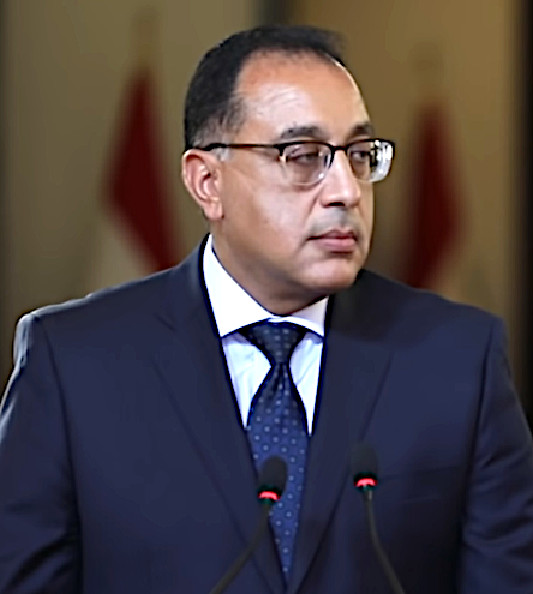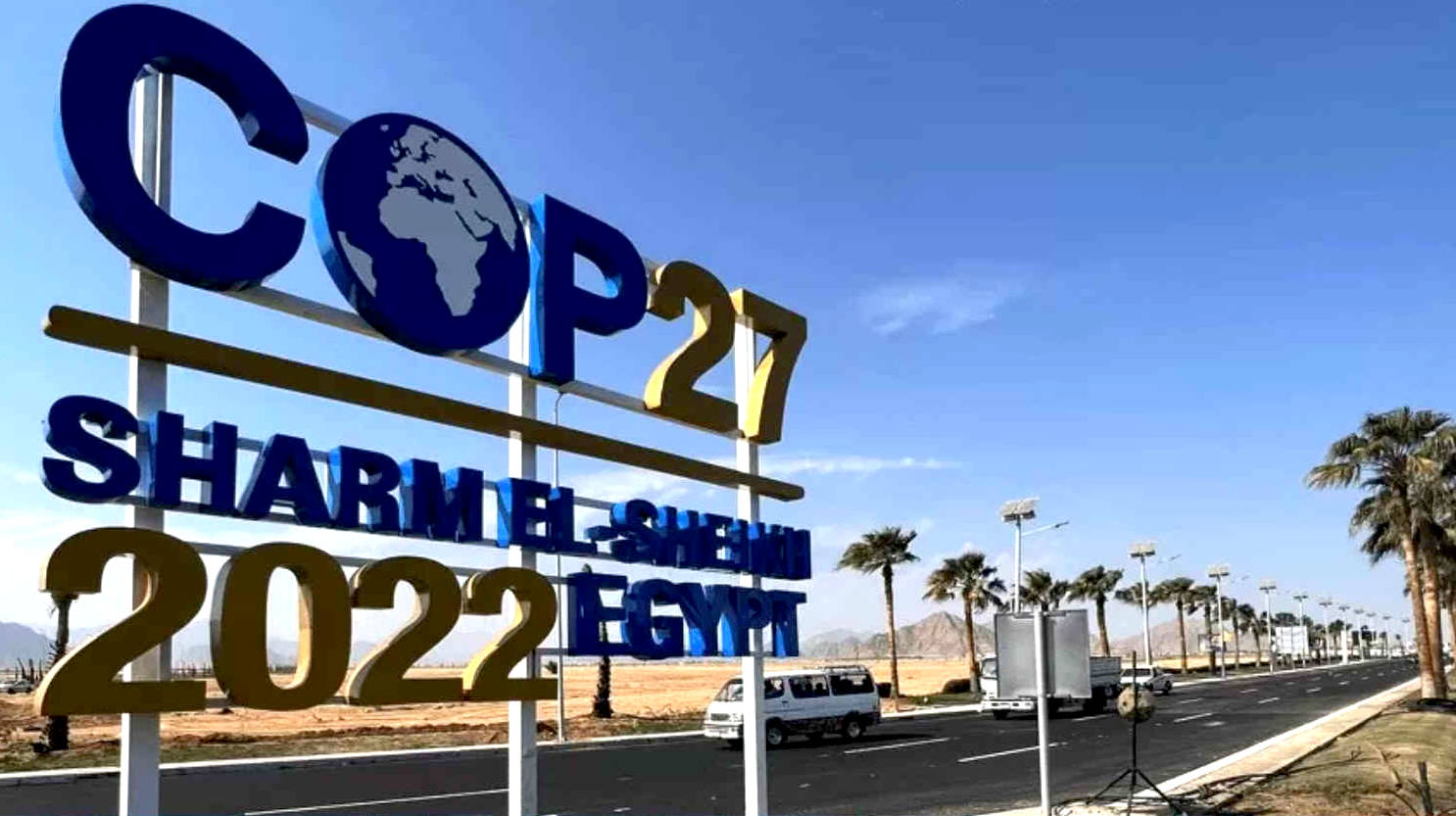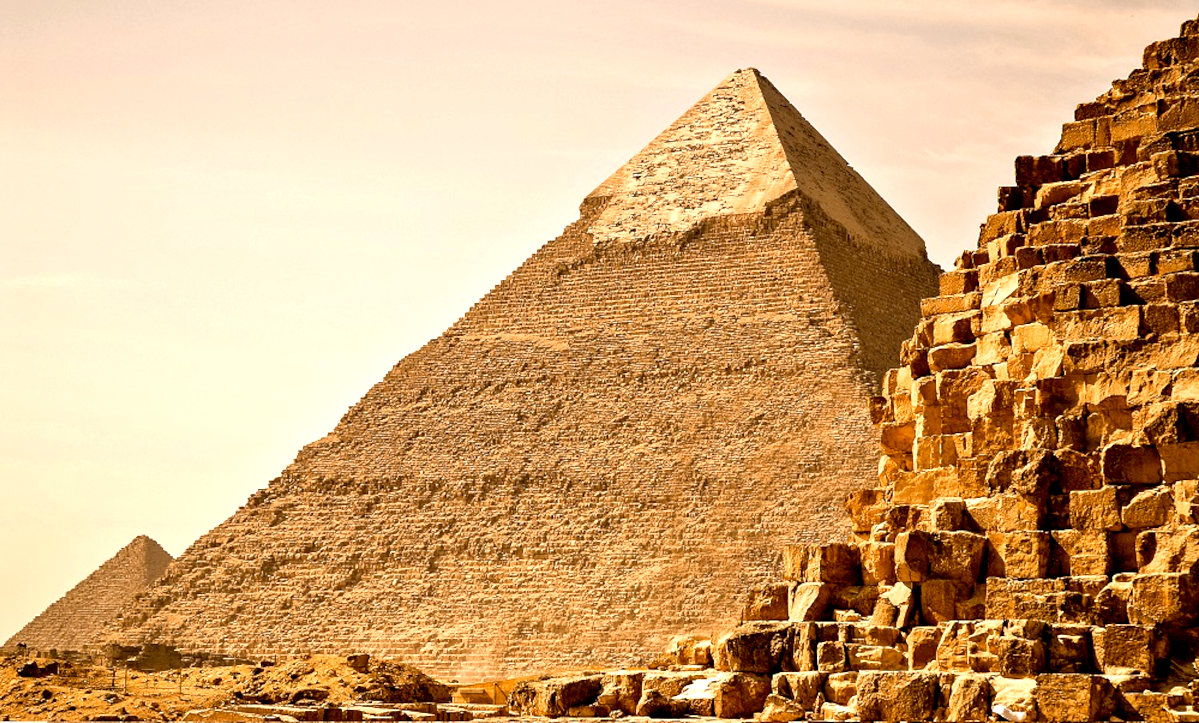|

COP27
looks set to be a hum-dinger of a conference, with compensation
on the Agenda
for the first time - right at the start.
To put Sharm El-Sheikh on the human rights map. While
it is true that the Parties, may not have prevented our world
from getting hotter, in all the twenty-seven years of talking
about it, at least they get together approximately once a year
to speak about their failures. Well,
not actually admit to failure, but to argue a point of view,
that allows them to continue to supercharge the atmosphere with
greenhouse gases, melt the icecaps and warm the oceans. So,
yes, the Group of Twenty, known as the G20,
know all about their failings, which they probably see as one-upmanship
- with scant regard for the natural world, or the extinction of
animals they are causing. Just so long as their economies are
growing. Or in the case of Russia, just so long as they have
enough fossil fuel bought munitions to invade the Ukraine, and
steal other lands aggressively.


Guardians
of the archaeological wonders of Ancient Egypt. Renewables
could play a big part in generating zero emission tours,
hence, climate friendly tourism, to bolster income, which in
turn might be used to further the protections of
antiquities, that nobody wants to see looted, rather stolen
items returned to Egypt, as part of the time encapsulation of the
Land of the Pharaohs.
And
that is the whole point. The culprits do not respect the natural
limitations of planet
earth. Some war criminals like Vladimir Putin, do not even
respect human life, taking it directly. Unlike the Ancient
Egyptians, whose culture was in tune with wildlife, the
Nile, and seasonal farming - and they did value human life.
Until they also upset the agricultural balance by removing the
trees that provided stability to the soil, that then got washed
away. At which point their civilization lost their ability to
produce crops, to be able to afford to build their giant pyramids.
Their economy failed, the reduction in size of the successive
pyramids, serving as an indicator, as to the rate of decline of
their agricultural
enterprise. It didn't help that they were invaded by the Romans.
Then, even Cleopatra's
supernatural ability to seduce her captors, would not work
forever. Those
with the biggest GDPs are burning up the planet at the rate of
2.4 times the sustainable rate, at which we might have achieved
a Circular
Economy. Can you imagine politicians telling us that all
those loans they'd taken out at a repayment schedule to appease
the Worlds Banks, now have to be paid back from an economy that
needs to be taken down to well under half what they'd been
promising to get themselves elected. Of course not. That kind of
truthfulness does not win elections. And bankers, will always
lend more than they should. Making it so, when they abandoned
the Gold Standard. Hey,
let's not worry about natural produce, or stability of the
planet. Let's just print more money. It's only paper, and we'll
be able to convert all those dunderhead voters to digital
nothingness - and they won't realise that they have been duped
again. We can blame it on the previous generations. That
is in effect what the money lenders have been selling, alongside
world leaders: We're all right Jack! WHAT
ABOUT ALL THE HOT AIR? COPs
have been held since 1995. Since when some progress has been
made, but only with promises. Nothing solid to bind the parties.
In fact, it may be that these conferences are seen as a
mechanism by which the greedier nations might bargain for more
time. All at the expense of the planet. Greedier, meaning more
than their fair share of energy, crops, and other natural
resources. Hence,
COPs have been more cop-outs, or flops. Where the intentions of
the nations with bigger economic needs, was to bargain with the
smaller entities, to allow them to continue to warm the planet.
Their intentions were not genuine, and they have not been
speaking in good faith. They have not come to the table with
clean hands.
1995
COP 1, BERLIN, GERMANY
1996
COP 2, GENEVA, SWITZERLAND
1997
COP 3, KYOTO, JAPAN
1998
COP 4, BUENOS AIRES, ARGENTINA
1999
COP 5, BONN, GERMANY
2000:COP
6, THE HAGUE, NETHERLANDS
2001
COP 7, MARRAKECH, MOROCCO
2002
COP 8, NEW DELHI, INDIA
2003
COP 9, MILAN, ITALY
2004
COP 10, BUENOS AIRES, ARGENTINA
2005
COP 11/CMP 1, MONTREAL, CANADA
2006
COP 12/CMP 2, NAIROBI, KENYA
2007
COP 13/CMP 3, BALI, INDONESIA
2008
COP 14/CMP 4, POZNAN, POLAND
2009
COP 15/CMP 5, COPENHAGEN, DENMARK
2010
COP 16/CMP 6, CANCUN, MEXICO
2011
COP 17/CMP 7, DURBAN, SOUTH AFRICA
2012
COP 18/CMP 8, DOHA, QATAR
2013
COP 19/CMP 9, WARSAW, POLAND
2014
COP 20/CMP 10, LIMA, PERU
2015
COP 21/CMP 11, Paris, France
2016
COP 22/CMP 12/CMA 1, Marrakech, Morocco
2017
COP 23/CMP 13/CMA 2, Bonn, Germany
2018
COP 24/CMP 14/CMA 3, Katowice, Poland
2019
COP 25/CMP 15/CMA 4, Santiago, Chile
2020
COP 26/CMP 16/CMA 5, Glasgow, Scotland
2021
COP 26/ Glasgow, Scotland 1-12 November
2022
COP 27/ Sharm El-Sheikh, Egypt, November
1995
COP 1, BERLIN, GERMANY
1996
COP 2, GENEVA, SWITZERLAND
1997
COP 3, KYOTO, JAPAN
1998
COP 4, BUENOS AIRES, ARGENTINA
1999
COP 5, BONN, GERMANY
2000:COP
6, THE HAGUE, NETHERLANDS
2001
COP 7, MARRAKECH, MOROCCO
2002
COP 8, NEW DELHI, INDIA
2003
COP 9, MILAN, ITALY
2004
COP 10, BUENOS AIRES, ARGENTINA
2005
COP 11/CMP 1, MONTREAL, CANADA
2006
COP 12/CMP 2, NAIROBI, KENYA
2007
COP 13/CMP 3, BALI, INDONESIA
2008
COP 14/CMP 4, POZNAN, POLAND
2009
COP 15/CMP 5, COPENHAGEN, DENMARK
2010
COP 16/CMP 6, CANCUN, MEXICO
2011
COP 17/CMP 7, DURBAN, SOUTH AFRICA
2012
COP 18/CMP 8, DOHA, QATAR
2013
COP 19/CMP 9, WARSAW, POLAND
2014
COP 20/CMP 10, LIMA, PERU
2015
COP 21/CMP 11, Paris, France
2016
COP 22/CMP 12/CMA 1, Marrakech, Morocco
2017
COP 23/CMP 13/CMA 2, Bonn, Germany
2018
COP 24/CMP 14/CMA 3, Katowice, Poland
2019
COP 25/CMP 15/CMA 4, Santiago, Chile
2020
COP 26/CMP 16/ CMA 5, Glasgow, Scotland
2021
COP 26/Glasgow, Scotland
2022
CP27/ Sharm El-Sheikh, Egypt
2023
COP 28/ Expo City, Dubai, UAE, 30 Nov - 12 Dec
2024
COP 29/ Absheron, Baku, Azerbaijan 11 - 24 November

But
these economic bullies, are caught up in a political world tied
to banking and fossil fuels that is corrupt to the core, in
terms of natural justice. You can blame them, but not stop them,
until they are forced to change by an informed electorate. And
for the most part the electorate can be bought. The proof of
that is in the pudding. The facts speak for themselves.

INTERESTING FACTS ABOUT ANCIENT EGYPT
1. CLEOPATRA WAS NOT EGYPTIAN
Along with King Tut, perhaps no figure is more famously associated with ancient Egypt than
Cleopatra
VII. But while she was born in Alexandria, Cleopatra was actually part of a long line of Greek Macedonians originally descended from Ptolemy I, one of Alexander the Great’s most trusted lieutenants. The
Ptolemaic Dynasty ruled Egypt from 323 to 30 B.C., and most of its leaders remained largely Greek in their culture and sensibilities. In fact, Cleopatra was famous for being one of the first members of the Ptolemaic dynasty to actually speak the Egyptian language.
2. SACRED ANIMALS
Cats were considered sacred animals by the Ancient Egyptians. It’s thought that most families kept a cat as a pet, which they believed would bring the household good luck. Harming a cat attracted harsh penalties for the
perpetrator.
3. INNOVATORS
The Ancient Egyptians invented lots of things we still use today, such as paper, pens, locks and keys and even; toothpaste. The colour blue was developed by the Egyptians.
Early chemical batteries may have been a thing, but for what
purpose is not known.
4. THE EARLIEST PEACE TREATY ON RECORD
For over two centuries the Egyptians fought against the Hittite Empire for control of lands in modern day Syria. The conflict gave rise to bloody engagements like 1274 B.C.’s Battle of Kadesh, but by time of the pharaoh Ramses II neither side had emerged as a clear victor. With both the Egyptians and Hittites facing threats from other peoples, in 1259 B.C. Ramses II and the Hittite King Hattusili III negotiated a famous peace treaty. This agreement ended the conflict and decreed that the two kingdoms would aid each other in the event of an invasion by a third party. The Egyptian-Hittite treaty is now recognized as one of the earliest surviving peace accords, and a copy can even be seen above the entrance to the
United Nations Security Council Chamber in New York.
5. THEY LOVED BOARD GAMES
After a long day’s work along the Nile River, Egyptians often relaxed by playing board games. Several different games were played, including “Mehen” and “Dogs and Jackals,” but perhaps the most popular was a game of chance known as “Senet.” This pastime dates back as far as 3500 B.C. and was played on a long board painted with 30 squares. Each player had a set of pieces that were moved along the board according to throwing sticks (in the same way we throw dice) to see how many squares to move your piece forward on the board. Historians still debate Senet’s exact rules, but there is little doubt of the game’s popularity. Paintings depict
Queen Nefertari playing Senet, and pharaohs like Tutankhamen even had game boards buried with them in their tombs.
Senet, was played for over 2,000 years!
6. ANCIENT EGYPTIAN WOMEN ENJOYED MANY HUMAN RIGHTS
While they may have been publicly and socially viewed as inferior to men, Egyptian women enjoyed a great deal of legal and financial independence. They could buy and sell property, serve on juries, make wills and even enter into legal contracts. Egyptian women did not typically work outside the home, but those who did usually received equal pay for doing the same jobs as men. Unlike the women of ancient Greece, who were effectively owned by their husbands, Egyptian women also had the right to divorce and remarry. Egyptian couples were even known to negotiate an ancient prenuptial agreement. These contracts listed all the property and wealth the woman had brought into the marriage and guaranteed that she would be compensated for it in the event of a divorce.
7. EGYPTIAN WORKERS ORGANIZED LABOUR STRIKES
Even though they regarded the pharaoh as a kind of living god, Egyptian workers were not afraid to protest for better working conditions. The most famous example came in the 12th century B.C. during the reign of the New Kingdom pharaoh Ramses III. When laborers engaged in building the royal necropolis at Deir el-Medina did not receive their usual payment of grain, they organized one of the first recorded strikes in history. The protest took the form of a sit-in: The workers simply entered nearby mortuary temples and refused to leave until their grievances were heard. The gamble worked, and the laborers were eventually given their overdue rations.
8. PYRAMIDS WERE TOMBS FOR PHARAOHS
Most Ancient Egyptian pyramids were built as tombs for pharaohs (rulers of Ancient Egypt) and their families. To date, over 130 pyramids have been discovered in Egypt.
9. THE AFTERLIFE WAS IMPORTANT TO THE EGYPTIANS
Much as with Christianity and going to heaven or hell. The Egyptians believed that by preserving a dead person’s body – which they did through the process of
mummification – their soul would live on in the
afterlife forever.
10. PHARAOHS WERE OFTEN OBESE
Egyptian art commonly depicts pharaohs as being trim and statuesque, but this was most likely not the case. The Egyptian diet of beer, wine, bread and honey was high in sugar, and studies show that it may have done a number on royal waistlines. Examinations of mummies have indicated that many Egyptian rulers were unhealthy and overweight, and even suffered from diabetes. A notable example is the legendary
Queen Hatshepsut, who lived in the 15th century B.C. While her sarcophagus depicts her as slender and athletic, historians believe she was actually obese and balding.
11. THE PYRAMIDS WERE NOT BUILT BY SLAVES
The life of a pyramid builder certainly wasn’t easy -
skeletons of workers commonly show signs of arthritis and other
ailments - but evidence suggests that the massive tombs were built not by slaves but by paid laborers. These ancient construction workers were a mix of skilled artisans and temporary hands, and some appear to have taken great pride in their craft. Graffiti found near the monuments suggests they often assigned humorous names to their crews like the “Drunkards of Menkaure” or the “Friends of Khufu.” The idea that slaves built the pyramids at the crack of a whip was first conjured by the Greek historian Herodotus in the fifth century B.C., but most historians now dismiss it as myth. While the ancient Egyptians were certainly not averse to keeping slaves, they appear to have mostly used them as field hands and domestic servants.
In the modern world, most people are financial slaves to
banks and kleptocrats.
12. KING TUT MAY HAVE DIED IN A HUNTING ACCIDENT
Surprisingly little is known about the life of the boy pharaoh Tutankhamen, but some historians believe they know how he died. Scans of the young king’s body show that he was embalmed without his heart or his chest wall. This drastic departure from traditional Egyptian burial practice suggests that he may have suffered a horrific injury prior to his death. According to a handful of Egyptologists, one of the most likely causes for this wound would have been a bite from a
hippopotamus. Evidence indicates that the Egyptians hunted the beasts for sport, and statues found in King Tut’s tomb even depict him in the act of throwing a
harpoon. If the boy pharaoh was indeed fond of stalking dangerous game, then his death might have been the result of a hunt gone wrong.
13. DENTISTS & OPTICIANS
An ancient physician was usually a jack-of-all-trades, but evidence shows that Egyptian doctors sometimes focused on healing only one part of the human body. This early form of medical specialization was first noted in 450 B.C. by the traveler and historian Herodotus. Discussing Egyptian medicine, he wrote, “Each physician is a healer of one disease and no
more … some of the eye, some of the teeth, some of what pertains to the belly.” These specialists even had specific names. Dentists were known as “doctors of the tooth,” while the term for proctologists literally translates to “shepherd of the anus.”
14. WEIGHTY STUFF
The Pyramid of Khufu at Giza is the largest Egyptian pyramid. This incredible structure weighs as much as
sixteen Empire State buildings.
15. IT'S A WRAP
Unwrapped, the bandages of an Ancient Egyptian mummy could stretch for 1.6km.
The cloth was sometimes treated with preservative. As in the
case of Cleopatra
in our story.
16. HIEROGLYPHICS
The Egyptian alphabet contained more than 700 hieroglyphs, the meaning of some of which is still open to interpretation.
17. WORSHIP
Ancient Egyptians believed in more than 2,000 deities! They had gods for everything, from dangers to chores! Each had different responsibilities and needed to be worshipped so that life could be kept in balance.
18. PETS R US
The Egyptians saw animals as incarnations of the gods and were one of the first civilizations to keep household pets. Egyptians were particularly fond of
cats, which were associated with the goddess Bastet, but they also had a reverence for
hawks, ibises,
dogs,
lions and baboons. Many of these animals held a special place in the Egyptian home, and they were often mummified and buried with their owners after they died. Other creatures were specially trained to work as helper animals. Egyptian police officers, for example, were known to use dogs and even trained
monkeys to assist them when out on patrol.
19. UNISEX (HEALING) MAKEUP
Vanity is as old as civilization, and the ancient Egyptians were no exception. Both men and women were known to wear copious amounts of makeup, which they believed gave them the protection of the gods
Horus and
Ra. These cosmetics were made by grinding ores like malachite and galena into a substance called kohl. It was then liberally applied around the eyes with utensils made out of
wood, bone and ivory.
The eye paint was usually green (made from copper) or black (made from lead).
Women would also stain their cheeks with red paint and use henna to color their hands and fingernails, and both sexes wore perfumes made from oil, myrrh and cinnamon. The Egyptians believed their makeup had magical healing powers: Research has shown that the lead-based cosmetics worn along
the Nile actually helped stave off eye infections.
20. LONGEST RIVER
The river Nile is the longest river in the
world at 4,132 miles long. It flows from Lake Victoria in East Africa up north through the Sahara Desert and finally drains in the
Mediterranean
Sea.
|




